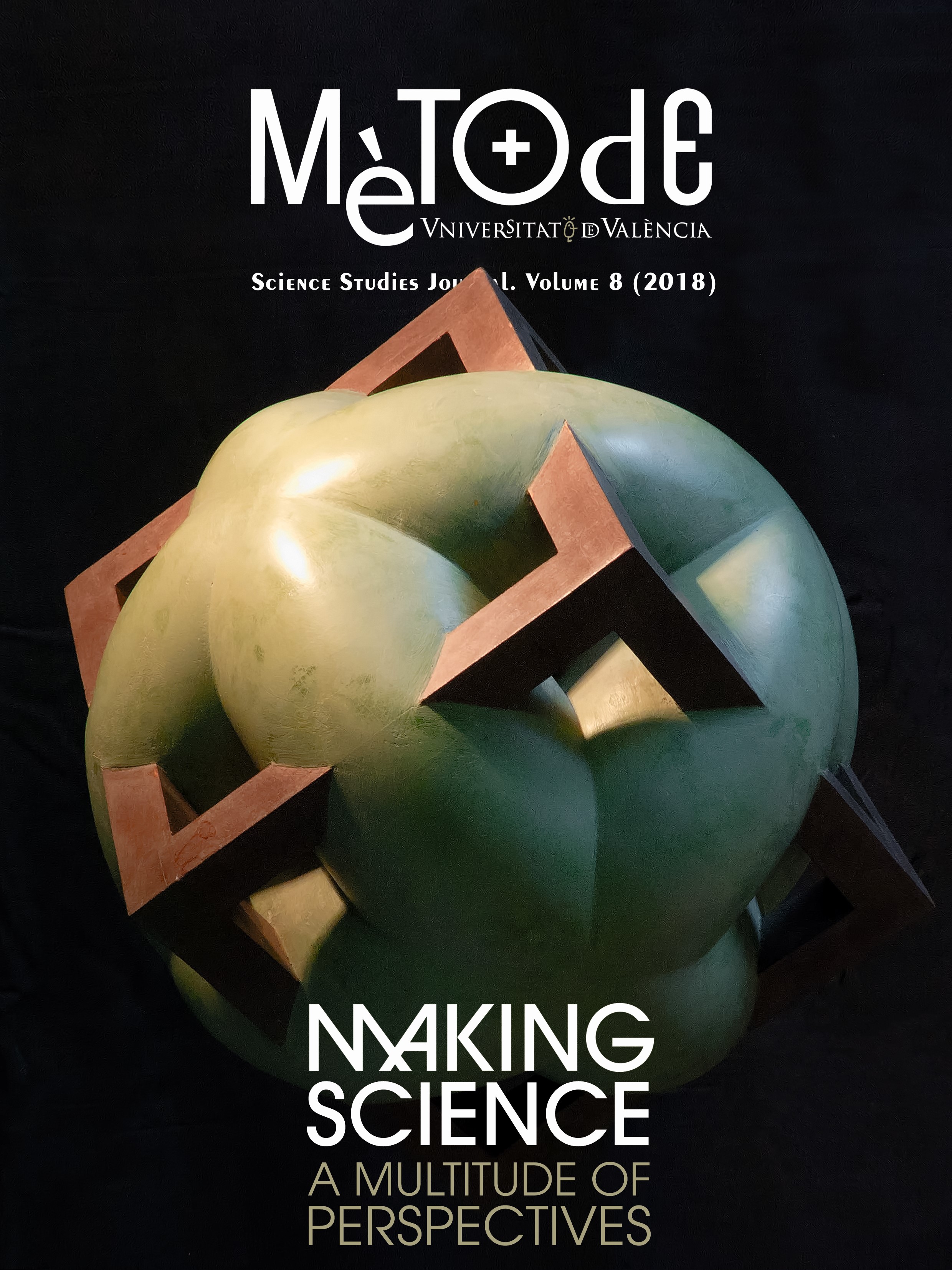Història i realitat del gènere ‘Homo’: Què és i per què el considerem com a tal?
DOI:
https://doi.org/10.7203/metode.8.9111Paraules clau:
taxonomia, gèneres, gènere Homo, paleoantropologia Resum
Resum
Els paleantropòlegs que s’ocupen d’investigar com s’organitza la naturalesa en espècies i com hauríem de denominar-les solen ser acusats de «limitar-se a discutir sobre noms». Aquesta idea implica que la taxonomia bàsica és una tasca administrativa avorrida que s’hauria de solucionar ràpidament, o fins i tot que s’hauria d’ignorar, per a poder arribar ràpidament a les qüestions realment interessants sobre l’evolució humana. No obstant això, la realitat és que mai entendrem la trama d’aquesta intricada obra que és l’evolució humana si no identifiquem amb precisió els actors que hi van participar. Aquest article revisa la formació del concepte actual del gènere Homo, que és summament vague, com a rerefons per a instar a realitzar una definició més racional.
 Descàrregues
Descàrregues
 Referències
Referències
Arsuaga, J. L., Martínez, I., Arnold, L. J., Aranburu, A., Gracia-Téllez, A., Sharp, W. D., … Carbonell, E. (2014). Neandertal roots: Cranial and chronological evidence from Sima de los Huesos. Science, 344, 1358–1363. doi: 10.1126/science.1253958
Collard, M., & Wood, B. (2015). Defining the genus Homo. In W. Henke, & I. Tattersall (Eds.), Handbook of paleoanthropology(2n ed., vol. 3, pp. 2107–2144). Heidelberg: Springer.
Dirks, P. H. G. M., Roberts, E. M., Hilbert-Wolff, H., Kramers, J. D., Hawks, J., Dosseto, A., … Berger, L. R. (2017). The age of Homo naledi and associated sediments in the Rising Star Cave, South Africa. eLife, 6e24231. doi: 10.7554/eLife.24231
Dobzhansky, T. (1944). On species and races of living and fossil man. American Journal of Physical Anthropology, 2, 251–265. doi: 10.1002/ajpa.1330020303
Haeckel, E. (1868). Natürlische Schöpfungsgeschichte. Berlin: Reimer.
Howell, F. C. (1957). The evolutionary significance of variation and varieties of Neanderthal man. The Quarterly Review of Biology, 32, 330–347. doi: 10.1086/401978
Keith, A. (1915). The antiquity of man. London: Williams and Norgate.
King, W. (1864). The reputed fossil man of the Neanderthal. Quarterly Journal of Science, 1, 88–97.
Leakey, L. S. B., Tobias, P. V., & Napier, J. R. (1964). A new species of Homo from Olduvai Gorge. Nature, 202, 7–9. doi: 10.1038/202007a0
Leakey, M. G., Spoor, F., Brown, F. H., Gathogo, P. N., Leakey, L. N., & McDougall, I. (2001). New hominin genus from eastern Africa shows diverse middle Pliocene lineages. Nature, 410, 433–440. doi: 10.1038/35068500
Linnaeus, C. (1758). Systema Naturae(10th ed.). Stockholm: Salvii.
Lordkipanidze, D., Ponce de León, M. S., Margvelashvili, A., Rak, Y., Rightmire, G. P., Vekua, A., & Zollikofer, C. P. E. (2013). A complete skull from Dmanisi, Georgia, and the evolutionary biology of early Homo. Science, 342, 326–331. doi: 10.1126/science.1238484
Mayr, E. (1950). Taxonomic categories in fossil hominids. Cold Spring Harbor Symposia on Quantitative Biology, 15, 109–118. doi: 10.1101/SQB.1950.015.01.013
Mayr, E. (1953). Comments on evolutionary literature. Evolution, 7(3), 273–281. doi: 10.2307/2405739
Oakley, K. P. (1949). Man the toolmaker. London: Trustees of the British Museum.
Robinson, J. T. (1951). Meganthropus, australopithecines and hominids. American Journal of Physical Anthropology, 11, 1–38. doi: 10.1002/ajpa.1330110112
Schwartz, J. H., & Tattersall, I. (2015). Defining the genus Homo. Science, 349, 931–932. doi: 10.1126/science.aac6182
Semaw, S., Renne, P., Harris, J. W. K., Feibel, C. S., Bernor, L., Fesseha, N., & Mowbray, K. (1997). 2.5 million-year-old stone tools from Gona, Ethiopia. Nature, 385, 333–336. doi: 10.1038/385333a0
Sutikna, T., Tocheri, M. W., Morwood, M. J., Saptomo, E., Jatmiko, Awe, R. D., … Roberts, R. G. (2016). Revised stratigraphy and chronology for Homo floresiensis at Liang Bua in Indonesia. Nature, 532, 366–369. doi: 10.1038/nature17179
Tattersall, I. (1993). The human odyssey. Englewood Cliffs, NJ: Prentice-Hall.
Tattersall, I. (2015a). Homo ergaster and its contemporaries. In W. Henke, & I. Tattersall (Eds.), Handbook of paleoanthropology(2nd ed., Vol. 3, pp. 2167–2188). Heidelberg: Springer.
Tattersall, I. (2015b). Defining and recognizing the genus Homo. Gortania, 36, 5–22.
Tattersall, I. (2016). The genus Homo. Inference: International Review of Science, 2(1). Retrieved from inference-review.com/article/the-genus-homo
Theunissen, B. (1988). Eugéne Dubois and the Ape-Man from Java: The history of the first “missing link” and its discoverer. Dordrecht/Boston: Kluwer Academic.
Villmoare, B., Kimbel, W. H., Seyoum, C., Campisano, E. N., DiMaggio, E. N., Rowan, J., … Reed, K. E. (2015). Early Homo at 2.8 Ma from Ledi-Geraru, Afar, Ethiopia. Science, 347, 1352–1355. doi: 10.1126/science.aaa1343
Weidenreich, F. (1939). Six lectures on Sinanthropus pekinensis and related problems. Journal of the Geologicual Society of China, 19, 1–110. doi: 10.1111/j.1755-6724.1939.mp19001008.x
Wood, B., & Collard, M. (1999). The human genus. Science, 284, 65–71. doi: 10.1111/j.1755-6724.1939.mp19001008.x
Descàrregues
Publicades
Com citar
-
Resum2190
-
PDF 919
Número
Secció
Llicència
![]()
Tots els documents inclosos en OJS són d'accés lliure i propietat dels seus autors.
Els autors que publiquen en aquesta revista estan d'acord amb els següents termes:
- Els autors conserven els drets d'autor i garanteixen a la revista el dret a la primera publicació del treball, llicenciat baix una llicència de Reconeixement-NoComercial-SenseObraDerivada 4.0 Internacional de Creative Commons, que permet a altres compartir el treball amb un reconeixement de l'autoria del treball i citant la publicació inicial en aquesta revista.
- Es permet i s'anima els autors a difondre la versió definitiva dels seus treballs electrònicament a través de pàgines personals i institucionals (repositoris institucionals, pàgines web personals o perfils a xarxes professionals o acadèmiques) una vegada publicat el treball.





